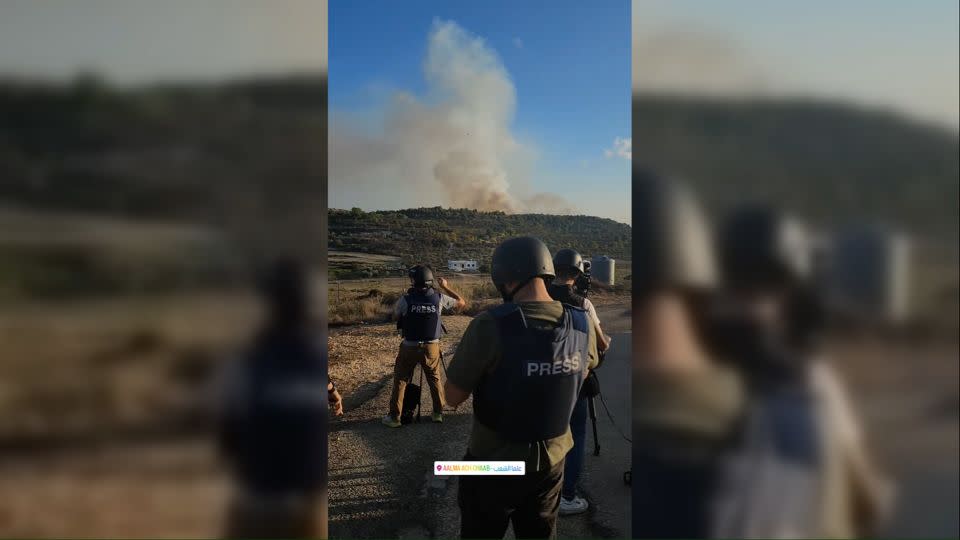Journalists hit as Israel fired at Lebanon were clearly marked as press, CNN analysis shows
The journalists were wearing body armor clearly labeled as “press” when Israeli forces struck Lebanon on Friday; the sudden blast killed Reuters journalist Issam Abdallah and wounded at least six others, according to official statements and videos analyzed by CNN.
Journalists from international news organizations Al Jazeera, Agence France Presse, and Reuters were among the victims, according to statements from their outlets.
Roughly around the same time – about 5 p.m local – the Israeli military said that it had fired artillery at Lebanese territory after a border fence exploded near the Israeli kibbutz of Hanita.
The Israel Defense Forces (IDF) said Saturday it was looking into the “incident with [a] Reuters journalist” killed in southern Lebanon.
Hanita is just across the border from the Lebanese town of Alma Chaab, where the group of journalists was covering the exchange of fire, CNN’s video analysis shows.
A Reuters livestream showed smoke rising from the area, according to CNN’s geolocations, before a thud is heard.
In the next instant, the camera lens is suddenly covered with dust, and a woman can be heard screaming in the background.
“Oh god. Oh god. What’s happening? … I can’t feel my legs,” she cries.
Christina Assi, a journalist for Agence France Presse, was later seen in video of the aftermath lying on the ground with leg wounds.
Abdallah, a videographer for Reuters, was found dead after the attack. He had been operating the live signal that recorded the fateful moment, the news agency said.
In a report published Saturday, Reuters said two of its journalists who were wounded in the attack recounted the press grouping was filming incoming fire from the direction of Israel when a missile hit Abdallah as he was “sitting on a low stone near the rest of the group.”
Reuters has not yet determined if Israel was behind the attack, though it has said that the strike came from the direction of Israel. Some other outlets, including Al Jazeera and the Associated Press, have said the shells were Israeli.
Without naming Abdallah, IDF spokesman Lt. Col. Richard Hecht said on Saturday his death was “a tragic thing,” which they are “very sorry for,” but did not admit it was an Israeli strike that took his life. He added that they have “visuals” of the incident and are cross examining them.”

Social media posts show that the victims were clearly identifiable as media. In the hour before the attack, Assi posted a video on her Instagram stories showing the whole group wearing helmets and protective vests clearly labeled as “Press.
Just before his death, Abdallah had posted on Instagram a photo of himself wearing a helmet and a press vest, smoke billowing in the distance behind him, with his location listed as Alma Chaab. Later, video showing his charred body showed the same spot in Alma Chaab, according to geolocation analysis by CNN’s open-source team. The site was first geolocated by opensource expert Benjamin Pittet of Geoconfirmed.
A few meters away from Abdallah’s body, a vehicle can be seen in flames. Lebanon’s army released a statement on Saturday saying the car was a “press car” and had been hit by an Israeli projectile.
In videos verified by CNN of the aftermath of the attack, at least two other journalists are seen bloodied. In one video, American journalist Dylan Collins from AFP is seen with his head and a wrist in a bloodied bandage, his shirt stained in blood and covered in dust. Medics rush to their aid.
Someone can be heard saying, “Leave that one, save who you can.”
Israel and militants in Lebanon have been engaged in a tit for tat exchange of fire on the border between the two countries since last weekend, when Hamas’ Oct 7 surprise attack on Israel, and Israel’s attack on Gaza that followed, prompted regional tensions to spiral.
Hezbollah, a Lebanese armed group backed by Iran, said it fired at four different Israeli locations on Friday. No party has claimed responsibility for the border explosion near Hanita, but Palestinian militants in Lebanon are known to have repeatedly launched attacks on Israel over the last week.
Minutes after the Israeli military’s statement acknowledging it had fired toward Lebanese territory, Lebanon’s state news agency released two statements saying that Israel had fired several rounds of artillery at Alma Chaab and the surrounding areas.
A Lebanese security source told CNN that an Apache helicopter was also seen over the location where the journalists were attacked, and that a tank — which may have fired the artillery — was on the Israeli side of the border area.
Earlier on Friday, a CNN team had met Abdallah at a pro-Palestinian rally being covered by journalists at the border town of Maroun el-Ras. A seasoned journalist who has covered conflict in the Middle East for many years, he appeared to be in good spirits.
Abdallah had a live Instagram feed that was still running for hours after he was reported dead. His last Instagram post was a picture of the late Palestinian journalist Shireen Abu Akleh, whom CNN found was likely killed by Israeli forces while she was covering an Israeli raid in the occupied West Bank last year.
CNN’s Ben Wedeman and Charbel Mallo contributed to this report from southern Lebanon.
For more CNN news and newsletters create an account at CNN.com

